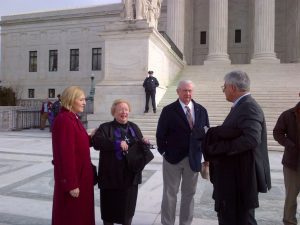SCOTUS Victories for Pro-Life Speech: McCullen, SBA List

June 26, 2013. Washington, D.C. While we are still waiting for the Court’s ruling on the HHS Mandate cases, today, the U.S. Supreme Court issued a victory for pro-life sidewalk counseling in the McCullen v. Coakley buffer zone case, with a separate victory for pro-life election speech being issued last week in Susan B. Anthony List v. Driehaus.
Bioethics Defense Fund attorneys Nikolas T. Nikas and Dorinda C. Bordlee filed key amicus briefs in both Supreme Court cases, with Chief Justice Roberts adopting a quote of a leading historian provided in the BDF buffer zone brief.
Buffer Zone Case: Peaceful Prolife Counseling at Abortion Facilities
In the Supreme Court decision in McCullen v. Coakley, No. 12-1168, the U.S. Supreme Court struck down a Massachusetts law that made it a crime for Eleanor McCullen and other pro-life counselors to peacefully offer pamphlets to women about abortion alternatives and the humanity of the unborn child within 35-feet of an abortion facility.
Nikolas T. Nikas said, “We are pleased that Justice Robert’s majority opinion quoted the words of a noted historian provided to the Court in our BDF amicus brief to find that government bans on ‘one-on-one communication’ impose ‘an especially significant First Amendment burden.’”:
As a leading historian has noted:
“It was in this form-as pamphlets-that much of the most important and characteristic writing of the American Revolution appeared. For the Revolutionary generation, as for its predecessors back to the early sixteenth century, the pamphlet had peculiar virtues as a medium of communication. Then, as now, it was seen that the pamphlet allowed one to do things that were not possible in any other form.” B. Bailyn, The Ideological Origins of the American Revolution 2 (1967).
Nikas said, “The Court’s ruling is a victory against the censorship imposed by Massachusetts lawmakers who failed to recognize that peaceful pamphleteering is one of the most protected and time-honored forms of speech in our nation’s history and jurisprudence.”
As recognized by the Court’s majority opinion by Chief Justice Roberts, Eleanor McCullen is a model of effective pro-life counseling:
They attempt to engage women approaching the clinics in what they call “sidewalk counseling,” which involves offering information about alternatives to abortion and help pursuing those options. Petitioner Eleanor McCullen, for instance, will typically initiate a conversation this way: “Good morning, may I give you my literature? Is there anything I can do for you? I’m available if you have any questions.” App. 138. If the woman seems receptive, McCullen will provide additional information. McCullen and the other petitioners consider it essential to maintain a caring demeanor, a calm tone of voice, and direct eye contact during these exchanges. Such interactions, petitioners believe, are a much more effective means of dissuading women from having abortions than confrontational methods such as shouting or brandishing signs, which in petitioners’ view tend only to antagonize their intended audience.In unrefuted testimony, petitioners say they have collectively persuaded hundreds of women to forgo abortions.
BDF represented amici maternal-fetal specialist John M. Thorp, Jr., M.D., and embryologist Maureen L. Condic, Ph.D. BDF’s Dorinda Bordlee said that in addition to addressing the highly protected form of speech known as pamphleteering, the amicus brief “demonstrated to the Court that pamphlets about when human life begins are medically accurate and highly relevant to the woman’s abortion decision, in accord with the Supreme Court’s own language recognizing the ‘profound moral issue’ at the heart of the abortion decision.”
Chief Justice Robert’s majority opinion in McCullen striking down the buffer zone law was joined by Justices Ginsburg, Breyer, Sotomayor, and Kagan. The decision ruled that the Massachusetts law was not narrowly tailored becaise ot burdened more speech than was necessary to serve the state’s interests.
Justice Scalia filed a tersely worded concurring opinion explaining that the result is right but that the majority’s reasoning reveals that it has an “abortion-speech edition of the First Amendment.” The Scalia concurrence was joined by Justices Kennedy and Thomas. Justice Alito filed a separate concurring opinion criticizing the majority’s finding that the Massachusetts law was “viewpoint neutral” given that “[s]peech in favor of the [abortion] clinic and its employees and agents is permitted; speech criticizing the clinic and its work is a crime.”
While the Justices disagreed as to whether the law was “content neutral,” all nine Justices agreed that the law is unconstitutional on the ground that it burdens more speech than is necessary to serve the Commonwealth’s asserted interests.
Speech Exposing Candidates who voted for tax-funded abortion in Obamacare
Last week, the Supreme Court ruled in Susan B. Anthony List v. Driehaus that the Susan B. Anthony List could pursue their challenge to an Ohio election law that criminalizes “false statements” about a candidate’s voting record. The pro-life group was censored and threatened with criminal prosecution for publically stating that a congressman’s vote for Obamacare was a vote for tax-funded abortion. An incumbant congressman running in the 2010 midterm elections claimed that the claims about abortion in Obamacare were false, but he ultimately lost his seat.
Bioethics Defense Fund filed an amicus brief with the Supreme Court confirming the truth of SBA’s statements, and surveying a multitude of ways that the Affordable Care Act authorizes and subsidizes elective abortion with public funding. The SBA’s claim that the Ohio law is unconstitutional is now proceeding in the U.S. Sixth Circuit, where BDF’s amicus brief is also pending.
- Read the McCullen v. Coakley decision on pro-life counseling at abortion facilities.
- Read the Susan B. Anthony List decision on free speech and elections.
BDF attorneys are carefully reviewing these decisions. For more updates and links to relevant news and journal articles, follow us on Facebook or Twitter.

















